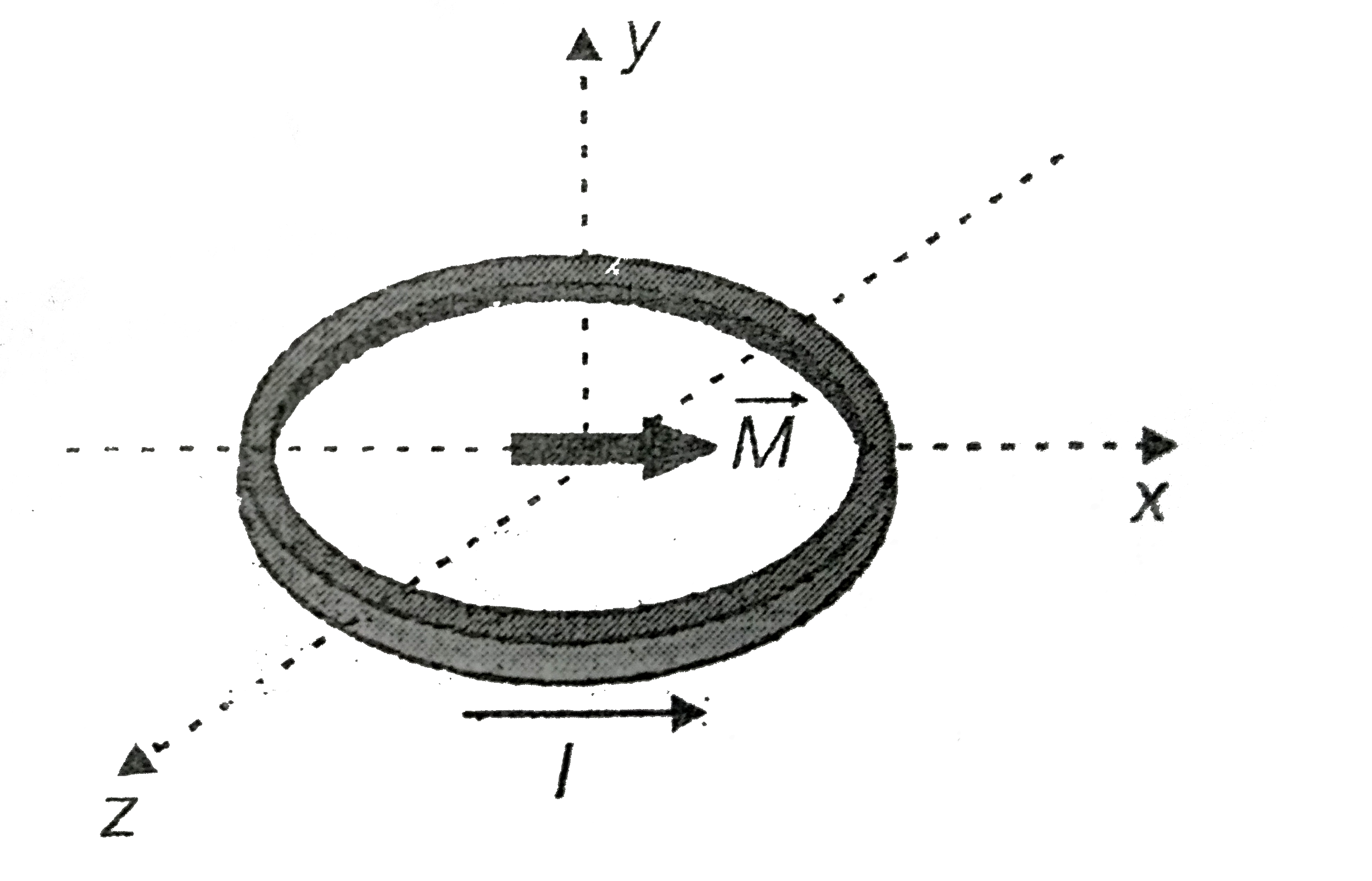Verify the Ampere's law for magnetic field of a point dipole of dipole moment −→M=Mˆk. Take C as the closed curve running clockwise along
(i) the z-axis from z=a>0 toz=R,
(ii) along the quarter circle of radius R and centre at the origin, in the first quadrant of x-z plane,
(iii) along the x-axis from x = R to x = a and
(iv) along the quarter circle of radius a and centre at the origin in the first quadrant of x-z plane. Solution in Gujrati
From P to Q, every point on the z-axis lies at the axial line of magnetic dipole of moment −→M. Due to this magnetic moment the point (0, 0, Z) at z distance the magnetic field induction,
B=2(μ04πMz3)
B=μ0M2πz3

(i) From Ampere.s law,
At point from P to Q along z-axis
∫QP→B.→dl=∫QPBdlcos0∘=∫RaBdz
=∫Raμ02πMz3dz=μ0M2π(−12)(1R2−1a2)
=μ0M4π(1a2−1R2)
(ii) Along the quarter circle QS of radius R is given in the figure below.

The point A lies on the equatorial line of the magnetic dipole of moment M sinθ. Magnetic field at point A on the circular arc is,
B=μ04πMsinθR3dlanddl=Rdθ
∴dθ=dlR
From Ampere.s law,
∴∫→B.→dl=∫Bdlcosθ
=∫π/20(μ04πMsinθR3)Rdθ
=μ0M4πR2∫π/20sinθdθ
=μ04πMR[−cosθ]π/20
=μ04πMR[−cos(π)2+cos0∘]
=μ0M4πR2=[0+1]
=μ0M4πR2
(iii) From Ampere.s law, along x-axis over the path ST, consider the figure given ahead.

From figure, every point lies on the equatorial line of magnetic dipole. Magnetic field induction at a point distance x from the dipole is,
B=μ04πMx3
∴∫TS→B.→dl=∫aR−μ0−→M4πx3.→dl=0 (∵Angle between−→Mand→dlis90∘)
∫TS→B.→dl=−μ04πx3∫aRdlcos90∘
(iv) Along the quarter circle TP of radius a. Consider the figure given below,

From case II line integral of →B along the quarter circle TP of radius a is circular arc TP.
∫→B.→dl=∫0π/2μ04πMsinθa3adθ
=μ04πMa2∫0π/2sinθdθ=μ0M4πa2[−cosθ]0π/2
=μ0M4πa2[−cos0∘+cos(π)2]
=μ0M4πa2[−1+0]
=−μ04πMa2
∴ For whole closed path PQST,
∴∮PQST→B.→dl=∫QP→B.→dl+∫SQ→B.→dl+∫PT→B.→dl
μ0M4π[1a2−1R2]+μ04πMR2+0+(−μ04πMa2)
∴∮PQST→B.→dl=μ0M4πa2−μ0M4πR2+μ0M4πR2−μ0M4πa2
=0
Topper's Solved these Questions
- BOOK - KUMAR PRAKASHANCHAPTER - MAGNETISM AND MATTEREXERCISE - SECTION D Multiple Choice Questions (MCQs) (MCQs From .DARPAN. Based On Textbook) Bar Magnet, Bar Magnet as Equivalent Solenoid27videos
MAGNETISM AND MATTER
- BOOK - KUMAR PRAKASHANCHAPTER - MAGNETISM AND MATTEREXERCISE - SECTION D Multiple Choice Questions (MCQs) (MCQs From .DARPAN. Based On Textbook) The Dipole in a Uniform Magnetic Field, Torque, Potential Energy, Periodic Time, Gauss.s Law23videos
MAGNETISM AND MATTER
- BOOK - KUMAR PRAKASHANCHAPTER - MAGNETISM AND MATTEREXERCISE - SECTION C NCERT Exemplar Solution ( Short Answer Type Questions )5videos
MAGNETISM AND MATTER
- BOOK - KUMAR PRAKASHANCHAPTER - ELECTROSTATIC POTENTIAL AND CAPACITANCEEXERCISE - Section D ( MCQs asked in Cometitive Exams )39videos
ELECTROSTATIC POTENTIAL AND CAPACITANCE
- BOOK - KUMAR PRAKASHANCHAPTER - MOVING CHARGES AND MAGNETISMEXERCISE - SECTION D (MCQs ASKED IN COMPETITIVE EXAMS)34videos
MOVING CHARGES AND MAGNETISM
Similar Questions
When a bar magnet is divided into two pieces,
04:43View SolutionNet magnetic flux passing through any closed surface in a magnetic field is always ......
12:14View SolutionVerify the Gauss's law for magnetic field of a point dipole of dipole moment −→M at the origin for the surface which is a sphere of radius R.
02:28View SolutionCapacitance of a capacitor 100 μ F. The work is done for depositing chargc 8×10−18 C on it will be .........
03:53View SolutionElectric charge Q having mass M moves on a circular path of radius R with velocity →v, perpendicular to uniform magnetic field B. When a particle completes one revolution, work done by the field is _______
01:24View SolutionVerify the Gauss's law for magnetic field of a point dipole of dipole moment M at the origin for the surface which is a sphere of radius R.
03:36View SolutionVerify the Ampere's law for magnetic field of a point dipole moment →M=Mˆk. Take C as the closed curve running clockwise along (i) z-axis from z=a>0 to z=R, (ii) along the quarter circle of radius R and centre at the origin, in the first quadrant of x-z plane, (iii) along the x-axis from x=R to x=a, and (iv) along the quarter circle of radius a and centre at the origin in the first quadrant of x-y plane.
04:16View SolutionA plane electromagnetic wave travels in free space along x-axis. At a particular point in space, the electric field along y-axis is 9.3 V m^(–1) . The magnetic induction (B) along z-axis is
11:14View SolutionA short electric dipole is situated at the origin of coordinate axis with its axis along x-axis and equator along y-axis. It is found that the magnitudes of the electric intensity and electric potential due to the dipole are equal at a point distance r=√5m from origin. Find the position vector of the point in first quadrant.
09:06View SolutionA proton is moving along Z -axis in a magnetic field. The magnetic field is along X -axis. The proton will experience a force along
08:16View Solutionif x>m,y>n,z>r(x,y,z>0) such that ∣∣ ∣ ∣∣xnrmyrmnz∣∣ ∣ ∣∣=0
The value of xx−m+yy−n+zz−risView SolutionA ring carrying current l lies in x-z plane as shown. A short magnetic dipole with dipole moment directed along x-axis is fixed at origin. If the ring is free to move anywhere, then it will
 01:38View Solution
01:38View SolutionVerify the Gauss's law for magnetic field of a point dipole of dipole moment −→M at the origin for the surface which is a sphere of radius R.
01:54View SolutionVerify the Gauss's law for magnetic field of a point dipole of dipole moment M at the origin for the surface which is a sphere of radius R.
02:29View SolutionR त्रिज्या के गोलाकार के पृष्ठ के लिए मूल बिन्दु पर स्थित m द्विध्रुव आघूर्ण के किसी बिन्दु द्विध्रुव के चुम्बकीय क्षेत्र के लिए गाउस-नियम सत्यापित कीजिए।
03:03View Solution

